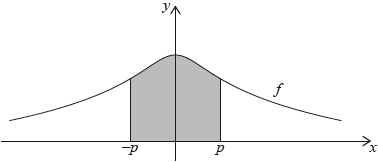| Date | May 2022 | Marks available | 3 | Reference code | 22M.2.AHL.TZ1.6 |
| Level | Additional Higher Level | Paper | Paper 2 | Time zone | Time zone 1 |
| Command term | Find | Question number | 6 | Adapted from | N/A |
Question
Consider the curve .
The shape of a piece of metal can be modelled by the region bounded by the functions , , the -axis and the line segment , as shown in the following diagram. The units on the and axes are measured in metres.
The piecewise function is defined by
The graph of is obtained from the graph of by:
- a stretch scale factor of in the direction,
- followed by a stretch scale factor in the direction,
- followed by a translation of units to the right.
Point lies on the graph of and has coordinates . Point is the image of under the given transformations and has coordinates .
The piecewise function is given by
The area enclosed by , the -axis and the line is correct to six significant figures.
Find .
Hence show that the equation of the tangent to the curve at the point is .
Find the value of and the value of .
Find an expression for.
Find the value of .
Find the value of .
Find the area enclosed by , the -axis and the line .
Find the area of the shaded region on the diagram.
Markscheme
(M1)
A1
[2 marks]
gradient at is M1
EITHER
M1
OR
M1
Note: Do not allow working backwards from the given answer.
THEN
hence AG
[2 marks]
(or ) (accept " ") A1A1
[2 marks]
A2
Note: Award A1 if only two correct transformations are seen.
[2 marks]
A1
[1 mark]
EITHER
Correct substitution of their part (b) (or ) into the given expression (M1)
OR
(M1)
Note: Award M1 for transforming the equivalent expression for correctly.
THEN
A1
[2 marks]
recognizing need to add two integrals (M1)
(A1)
Note: The second integral could be replaced by the formula for the area of a trapezoid .
A1
[3 marks]
EITHER
area of a trapezoid (M1)(A1)
OR
(M1)(A1)
Note: If the rounded answer of from part (b) is used, the integral is which would be awarded (M1)(A1).
THEN
shaded area (M1)
Note: Award (M1) for the subtraction of both and their area for the trapezoid from their answer to (a)(i).
A1
[4 marks]
Examiners report
The differentiation using the power rule was well done. In part (ii) some candidates felt it was sufficient to refer to the equation being the same as the one generated by their calculator. Generally, for ‘show that’ questions an algebraic derivation is expected.
The candidates were successful at applying transformations to points but very few were able to apply these transformations to derive the correct function h. In most cases it was due to not appreciating the effect the horizontal transformations have on x.
The candidates were successful at applying transformations to points but very few were able to apply these transformations to derive the correct function h. In most cases it was due to not appreciating the effect the horizontal transformations have on x.
Part (i) was frequently done well using the inbuilt functionality of the GDC. Part (ii) was less structured, and candidates needed to create a clear diagram so they could easily see which areas needed to be subtracted. Most of those who were successful used the formula for the trapezoid for the area they needed to find, though others were also successful through finding the equation of the line AB.


